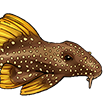Picking it up from where we left (and not harming Marc's Auchenipterid topic anymore) I quote and aswer:
Grokefish wrote:
Ive been thinking about the spider theory and I wonder if it is a defence mechanism of the spiders directly to these fish in the wild. Alot of wood cats are insectivores (and they don't know the scientific difference between insects and arachnids before some smartarse points this out) and these fish would probably be big enough to eat them in the wild so possibly a defence has been conjoured up by evolution/mother nature specifically between these animals.
Just another note arowanas do eat spiders in the wild so it would be a shame to deprive him of such biotopically correct delicacy for much longer......
This defense mechanism is NOT aimed at fish.
simply because of this: tarantula's can't swim! by the time a fish (Arowana, catfish any fish) can get at them the spider will die 100%. so even if an Arowana would spit out the spider due to the hairs, the spider would drown. a defense mechanism wich doesn't result in surviving animals doesn't make sense.
no, the trick with urticating hairs is that these are so small and so light that they can float in air. their shape is irritating on mucous membranes (eyes, nose, mouth), skin and respiratory organs of landbased vertebrates.
they're pretty useless against invertebrates, that's why army ants can and do kill and eat tarantula's.
Ageneiosidae are riverine fish. they don't live in temporary pools but they can live in a floaded forest. such a forest is huge. the effect of spiderhairs in the flooded forests of the Amazonian Rainforest is nil.
especially when compared to a small fishroom, moderately sized tanks and an airpumpsystem wich sucks spiderhair-saturated air in and distributes it through the water.
we STILL don't know for sure IF it was the spiders' hair that did in those Ageneiosus, but we pretty much eliminated every other source.....
There's another fault here and I spotted it only just now....it's highly unlikely the spiders' hairs can pass through a wet airstone! maybe some air travels through or powers filters? there the bubbles escape freely from the airhose and hence can carry the hairs.
but the hairs DO pass freely through the air and they do land on the surface of the tanks or travel from fingertips to the tankwater.
it's difficult.
I cannot see the room, i don't know wich species of spider we're talking about, I cannot take samples of the tankwater and put it under a microscope and i cannot dissect or check a dead catfish......

but I DO know that the spiders defense mechanism wasn't developed to deal with fish. if the culprits are the spiders it;s an unhappy coincidence.
3 things:
-I wouldn't write off the possibilities of gillflukes or skinflukes yet.
-I need to know the species of spider present in that room. some are so much more virulent when it comes to urticating hairs than others. for example Theraposa leblondi, Brachypelma and Acanthoscurria are very nasty hairkickers, whereas Psalmopoeus and Holothere are far less 'itchy'.
-I discovered I'm allergic to the hairs myself. usually in my case allergies show by extensive sneezing, red eyes and a shortage on air. now I just got very irritated eyes.....so I'm forced to switch from the American Theraposidae to the Asian spiders. no hairs there but no handling either! Spiders like Poecilotheria, Ceratogyrus, epebophus and the like are non irritating, but far more agressive and quite poisonous. so my home collection will be less itchy but a fair bit more dangerous.









